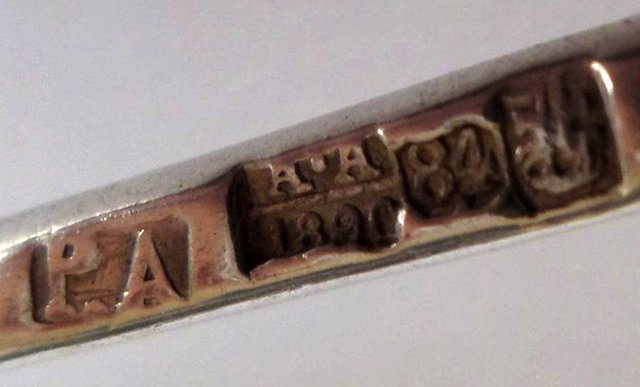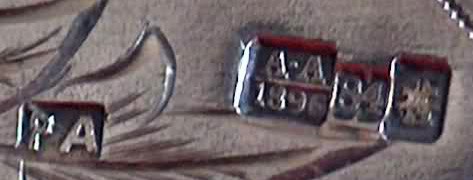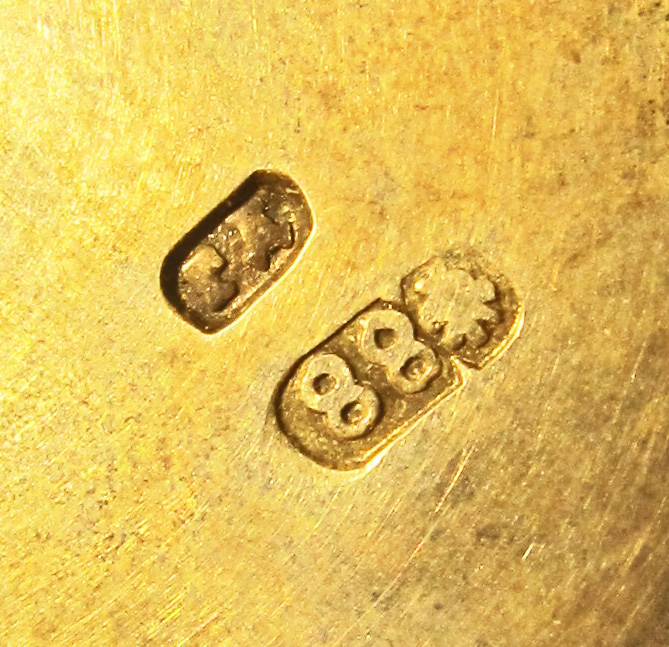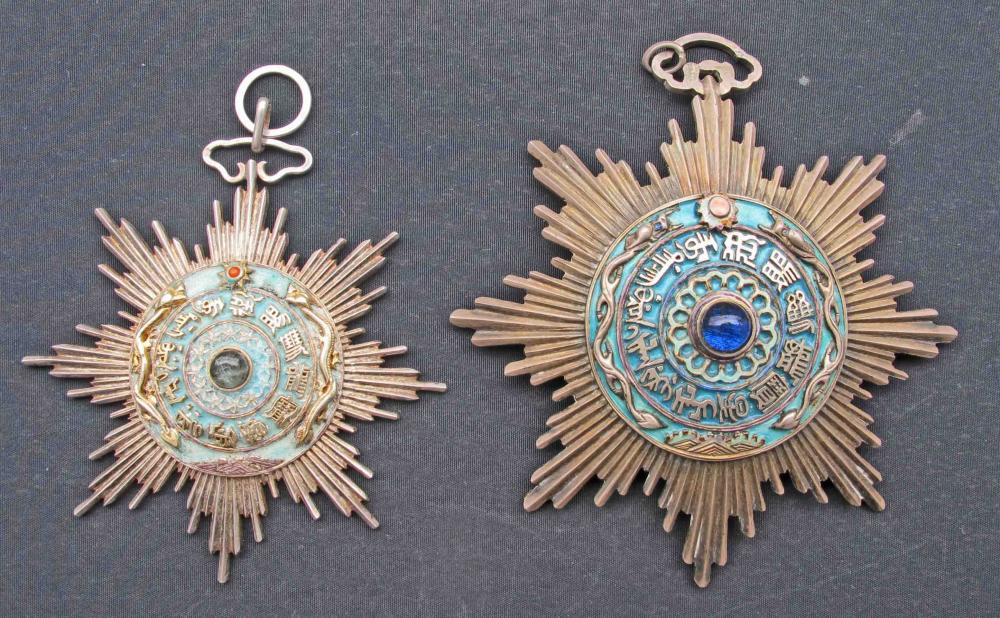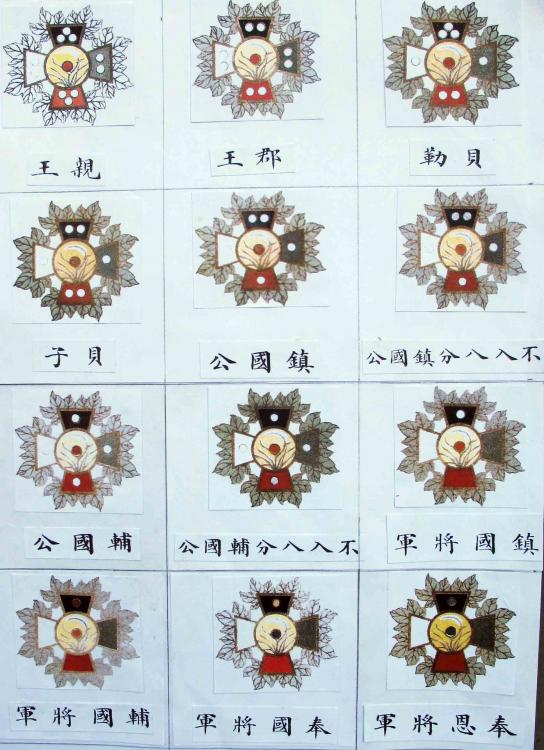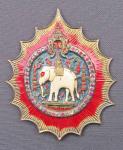
KIMKAN
Valued Member-
Posts
63 -
Joined
-
Last visited
Content Type
Profiles
Forums
Blogs
Gallery
Events
Store
Everything posted by KIMKAN
-
Dear all, Internet research has provided three images of the Roman Aristarkhov punchmark. Well, from a distance they look somewhat similar to that of my September 2017 question. The ГД = GD possibility must be worked out further as it has plenty of potential as well. The crux of the matter will be the actual name behind "GD" operating in St. Petersburg circa 1890-1900. Regards to all. KimKan
-
Dear all, China provided workers to assist French and England during World War I. As far as France is concerrned, circa 40.000 Chinese workers moved to France between 1916 and 1918 to support its war effort in various industries (factories, harbours, mines, agriculture etc....) as almost all valid French men had to join fighting units. All Chinese workers had a work contract and could not participate to any military action (working in defense industry was common practice though in breach of formal agreements with China). None has ever been involved with actual battle situation. No official French award has ever been issued to commemorate this rather unknown contribution. As far as I can tell, China has not done anything official as well. The only solution left is that of private veterans associations. I am of the opinion that this medal belongs to this unofficial category. Regards to all. KimKan
-
Dear all, Research conducted outside GMIC leads to believe that it could be a "P.A", (i.e "R.A" in latin alphabet) punchmark belonging to silversmith Roman Aristarkhov who was very active in Moscow in the years 1890-1900, i.e perfectly in line with a Chinese imperial award as some were made in Russia at that time and bear the initials of famous silversmiths (Bogdanov, Rupert etc....). The only issue to solve is why a Moscow-made award would end up in a Saint Petersburg store with the name of another famous siversmith on the box. Sub-contracting is a possibility as A.A Treidyen of Saint Peterburg could very well have sold items made by other silversmiths, not necessarily based in Saint Petersburg. Interesting stories behing a very simple punchmark.... Regards to all. KimKan
-
Dear all, Belated and sincere thanks to Joseph - Alpha Draconis - for his valuable input. I have not been able to get the medal back as I am not its owner. If I recall correctly, it was a foreign order, not a Russian order. A Chinese order of the Double Dragon is what I can recall though I did not examine it thoroughly. It was cased in a box bearing the stamp of A.A TREIYDEN in Saint Petersburg. Thanks anyway. Regards. KimKan
-
Dear all, Apparently, there are still some imperial nobility badges floating around as one of them is listed on the new Morton & Eden auction catalog and will be auctioned off on November 23rd + many many other Chinese items. These M&E catalogs are really well made and must be kept as important references over time. Regards KimKan
-
Dear all, Attached picture shows two punchmarks on the reverse side of a Russia-made breast star. A typical combined city and standard mark for St Petersburg + 88 zolotniki - is quite easy to read. The master's mark is more difficult to identify. The first letter looks like a "r" and the second like a "A", though both are somewhat blurred and not neatly struck. I have not found a possible match on the various links already provided on this site. Any idea on this silversmith's idendity ? Thanks in advance. Regards to all. KimKan
-
Dear all, A picture being worth a thousand words, two Double Dragon 3rd Class neck badges. The small 1st Grade is circa 75 mm wide and the larger 3rd Grade is close to 90 mm wide. Various makers, various standards....I do not think that there is any specific information or lesson to draw from that. Regards. KimKan
-
Dear all, Looking at the 1909 Nobility Badge decree, it is quite easy and fun to clip the various images pertaining to each grade. There are no less than 12 possible badges with tung leaves only, each with a different number of pearls, colours etc.... I suspect that a similar number of badges should come with tung leaves AND peony flowers. At the end of the day we should have close to 24 possible badges for the imperial period (yellow center). This is a highly complex system of badges that required a sharpshooter's eye to tell the right position of its wearer ! .... What puzzles everyone is the fact that these imperial area badges (almost) never turn up on the market while they were apparently structured to cover a fairly large population of noble people, ranging from first rank princes to marquis or viscounts. I do not know how many hundreds or thousands of peole this noble population included but we get absolutely nothing (or close to that) at the end of the pipe ! Can we be that sure that all of them were made and distributed ? The republican area Order of Rank and Merit is quite difficult to encounter indeed. The imperial area Nobility Badge is a collector's dream that is likely to never come true. Regards. KimKan
-
Dear all. Reply is YES, especially when it comes to badges made by European houses. The 75 mm wide is not the smallest size one can come across. Regards. KimKan
-
Dear all, Many interesting items on this post. The round silver medal with the words "mariage chretien" on the obverse and the intertwinned letters BI on the reverse has nothing to do with China or any other Far-Eastern country. This is a French silver wedding medal ("mariage chrétien" = "christian wedding"), a typical token offered in the 19th century to newly wed couples. The two letters on the reverse side are the initials of the bride and groom. Regards. KimKan
-
Dear all, This is it, this magnificent gold Chinese medal had to be auctioned off again as the mysterious April 2014 bidder never turned up to pay the 92,000 Euros he committed to. It was presented again on April 3rd 2015 by the same auction house in Paris and went for circa 28.000 Euros, all fees included. Still a nice price and an absolutely incredible piece with a solid pedigree. This is just one third of what it apparently went for one year ago as deposits and guarantees were required by the auction house to secure the transaction. A penny in your pocket is still better than a shilling in your dreams... Regards to all. KimKan
-
Dear all, This is it, the Pao Hsing 2nd Class in gold went for 21.500 Euros (including auction fees), i.e circa 24.000 US$ or 16.000 UK£. This was the highlight of the orders and medals sold that day. My April 5th 2014 thread on GMIC shed light on a similar attributed award (1st Class) which went for an astonishing 92.000 Euros, i.e 4 times more than two days ago. However, I take from the horse's mouth that it was never paid by the overseas "buyer". It is likely that auction houses have tightened their security process to avoid stupid bids like that, hence an apparently lower price though perfectly clean and reliable. The medal sold two days ago was nothing but a striking piece of Chinese jewellery with a robust pedigree, well worth the price paid for it. Regards to all. KimKan
-
Dear all, A hard-to-find 2nd Class Pao Hsing medal in pristine condition will be on sale at public auction in Paris next week : http://www.beaussant-lefevre.com/flash/index.jsp?id=21817&idCp=92&lng=fr A beautiful piece indeed bestowed upon a French civil engineer in 1881, just one year before the creation of the Double Dragon. Estimate of 8,000 to 12,000 Euros seems a bit low for that type of medal. We will see next week where the market stands. Regards to all. KimKan
-
Dear all, I have just received a magnificent glossy paper catalog of the November 15th militaria and medals auction to be run by the house of Carsten Zeige in Hamburg - Germany - (Internet link below). Items 465 to 518 are nothing but a great collection of imperial and republican Chinese awards, including attributed pieces with supporting photographs etc.... There will be another 1st type 3rd Class Double Dragon to be auctioned off in that sale, identical to that of the Kunker sale a few weeks ago but with an interesting chopmark on reverse. I am just wondering if 2014 has not been the most incredible year for Chinese medals auctions with high quality items being offered by Poly of Hong Kong, Spink and Morton & Eden of London, Kunker and Carsten Zeige in Germany plus other sales I have not mentioned and possible additional items between today and the end of 2014. I do not recall having seen so many interesting pieces in such a short period of time. Regards to all. KimKan http://www.zeige.com/en/index2.html
-
Dear all, The German auction House of Kunker will offer three Double Dragons early October, including a 1st type 3rd Class 1st Grade, under number 1545. Beautiful piece indeed. Link below. Regards to all KimKan https://www.kuenker.de/en/auktionen/stuecke/253-257?suchbegriff=1545&x=16&y=13
-
Dear all, Yes, a Russian makers'mark without the silver fineness guarantee mark looks a bit strange. The attached picture come from the Kunker auction of September 2011. Similar breast star but with all the required stamps and hallmarks. Feel a bit better about that one. Regards to all. KimKan
-
Dear all, Another ODD 1st type Russian breast star with the chop "MB" of Mikhail Bogdanov is up on the blocks. It will be auctioned off on September 23rd by Galerie Numismatique in Vienna - Austria. Different style from the Spink auction breast star but very elegant. Seems to be a 3rd Class (grade difficult to identify) with its typical central blue stone. The central blue medallion looks identical to those we find on the breast star made by Godet of Berlin, adding probability to the fact that this type of central medallion comes from China and was simply added to a locally made breast star, made either in Russia or in Germany. There are other interesting and high quality Chinese imperial awards on this sale. It is regrettable that some fakes have managed to sneak into this auction as well and that the sash ribbon of the 1st Class Golden Grain set has nothing to do with that order. The link is attached : http://coins-la-galerie-numismatique.com/auction-xxii/china/order-double-dragon-0 Regards to all. KimKan
-
Dear all, From a purely historical standpoint, the very first type of the Order of the White Elephant that covers the 1861-1865 period looks like the attached 1st Class badge. If I am not mistaken, four classes were created in 1861 for Thai nationals plus a single class for foreigners, i.e five different types but all of them in a similar breast star shape. This lasted till 1865 when the new breast star design that has been shown in this post was adopted with additional elements like breast badge, sash badge, neck badge etc...It is true that many changes and reforms have altered the organization and the design of this order in the 19th and 20th century. Excellent documentation does exist in Thai language, unfortunately much less in European vernaculars. Maa pen rai....("not to worry" in Thai...). Regards to all. KimKan
-
Yes, assuming that he did not receive a first type award and decided later on to replace it with a smaller 2nd type badge, we definitely have here an interesting time marker. I doubt he did that as he left China soon afterwards and sailed back to French Indochina. The badge he wears looks very much like a China-made piece of the period. Depending on the locale and availability of old-new badges, we may very well have a mix of 1st and 2nd type badges awarded during the Boxer rebellion. Other fully documented award like this one, if any ever crops up, will shed additional light on this issue. Regards to all. KimKan
-
Dear all, I am pleased to post the picture of a larger-than-life figure of the French colonial army. His name is Eugène Jean Paul Marie FONSSAGRIVES who was born in 1858 and passed away in 1937. He graduated from the French Saint Cyr military academy in 1879. His military career reads like a Hollywood movie script, the only difference being that it is real. He was given many assignments and took part in several important campaigns within the French “navy infantry”, something equivalent to the “marines” in the British or American vocabulary. We can see him on the battlefield in Tunisia in 1882-84, in the Tonkin in 1887-1890, in Dahomey (Africa) in 1892-1893, in Cambodia, Hanoï and Saïgon between 1896 and 1900, in China during the Boxer rebellion in 1900-1901, in Senegal between 1905 and 1907, in Morocco in 1909 and finally on the battlefield again in Belgium in 1914. Wounded several times, he ended up his career as colonel, a meager reward in view of his outstanding services. Short-fused and bad tempered, his frequent disagreements and furious outbursts with the upper echelons of the French army did not allow him to get the stars on his sleeves. Of interest to this post focusing on China is the 1900-1901 Boxer rebellion campaign. At that time, FONSSAGRIVES was a major with the 17th Colonial Infantry Regiment, a unit hastily put together for the China relief expedition. He was sent north of Beijing to protect the Ming imperial tombs from being looted by either local thugs or by soldiers of the foreign armies. He perfectly carried out this mission, to the utmost satisfaction of the imperial Chinese government. Military reports indicate that an official Chinese delegation led by the brother of the Emperor paid a visit to him on December 13th 1900 to express satisfaction. On April 18th 1901, FONSSAGRIVES and his unit left their post at Lai-Siu-Sien and were officially greeted by all local mandarins. On May 18th 1901, an emissary of minister Li Hung Chang presented FONSSAGRIVES with the Order of the Double Dragon, 3rd Class. The picture attached to this post was taken at the end of 1913 when FONSSAGRIVES was promoted colonel, commanding officer of the 5th Colonial Infantry Regiment. We can see that he wears his second type ODD 3rd Class around the neck. This story is most interesting as a Boxer rebellion-related ODD is not a common situation at all in the first place. Then, we have the year, month and day for a second type award, just touching upon that specific period for which legitimate questions may arise as to whether or not first or second type ODD award was the norm. I hope you have enjoyed this post. Regards to all. KIMKAN
-
Dear all, I am not convinced that the wording "French-made copy for collectors from early 20s" is completely appropriate. At that time, many French makers (Halley, Dupetitboscq, Bacqueville etc....) produced a fairly large array of high-quality foreign awards (their catalogs testify to this) just because there was a strong local demand for these items, mostly stemming out of French officers-officials-diplomats-celebreties etc... that did receive these awards and were looking for a replacement (in case of loss or theft), a second or even a third item (some parade uniforms had these awards permanently fixed on them). The word "copy" is not appropriate in most cases as these awards were legitimate pieces, frequently approved (at least not objected to) by foreign legations in Paris. The word "collectors" seems to be off the mark as well as the most important customer base for those were not collectors but people who were eligible to these awards in the first place. Collectors may have stepped in and increase demand, no doubt about that. However, I suspect that their final input was limited and could not have justified a costly industrial production. Regards to all. Kiman
-
Dear all, Nobody can challenge the fact that art prices (including numismatic items, medals, orders and decorations....) bear a strong relationship with the current state of the economy and the (apparent) financial propsperity of a country at a given point in time. What we have all observed over the past ten to fifteen years with respect to Russian and Chinese medals testifies to this. You need both trucks of money, a taste for your own country's history and also an occasional appetite for show-off and public tap-dancing at the forefront of an auction room to drive prices that high. China is still in that mood these days as the economy is still vibrant and expanding, money readily available, "nationalistic taste" very present and willingness to be regarded as a fast lane driver in auction rooms quite easy to spot. To top it all, number of high-quality Chinese items is not that large due to limited award policy at the onset combined to many civil and international war destructions at a later stage. As a result, we may still expect big surprises when it comes to record-breaking prices. Russia seems to go towards a completely different direction. Current economic and financial situation is just on the verge of disaster and things will get worse before they get any better. International sanctions and penalties resulting from the Ukrainian crisis will hit hard in 2014 and 2015 and are likely to shake the Russian economy upside down. No doubt some corporates and financial institutions will soon go by the wayside. Why would you expect art prices to keep going up at a time those affluent buyers of the past start thinking how to stack up money outside their own country ? Trust and stability is a very important factor in the mind of the collector turned investor as this dual nature is at stake at these price levels. Regars to all KimKan
-
Dear all, The Bogdanov breast star has reached 18,000 UK£ this afterrnoon during the Spink auction, close to five times the estimate ! Adding auction costs and commissions, we should be close to 22,000 UK£, i.e circa 37,000 US$ to be paid by the buyer.This is solid money indeed. It was an extraordinary item, perhaps worth such a small fortune. Regards. KimKan



